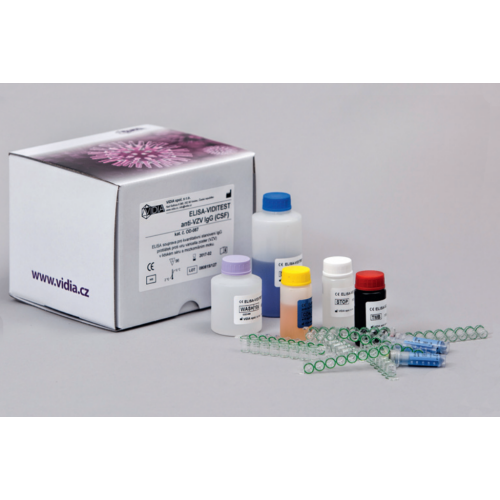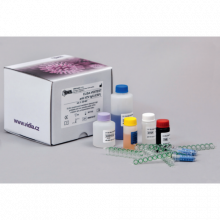
Anti-VZV IgG and IgG avidity ELISA kit, 48 tests
(Cat#: ODZ-233)
Description
The ELISA-VIDITEST anti-VZV IgG and IgG avidity kit is intended for in vitro diagnosis of VZV (varicella-zoster virus)-associated diseases, namely varicella and herpes zoster. The test can also be utilized for the differential diagnosis of neuroinfections, infections of the eye and of exanthematous diseases of the skin. VZV IgG avidity determination can be used for differentiation between the primary VZV infection and reactivation or reinfection.
This assay is a solid-phase immuno-analytical test. The polystyrene strips are coated with a native antigen containing immunodominant epitopes of VZV. Serum samples are applied into two parallel wells and the anti-VZV antibodies present in the samples bind to the immobilized antigens. One well is incubated with the wash buffer and the parallel well is incubated with the urea solution. Antibodies with low and high avidity remain bound to the antigen in the first well, whereas in the second well the low avidity antibodies are released due to the high concentration of urea. The bound antibodies are recognized by animal antihuman IgG antibodies labeled with horseradish peroxidase. The amount of the bound labeled antibodies is revealed by an enzymatic reaction that leads to a color change. The presence of the low avidity antibodies is indicated by a drop of absorbance in wells in which the urea solution was added. The ratio between the optical density of the well without urea and the corresponding well with urea represents the relative avidity index.
- Solid-phase immuno-analytical test for detection of IgG antibodies to VZV and avidity evaluation
- Used with human serum
- High sensitivity and specificity
- Semi quantitative evaluation
- Diagnosis of VZV-associated diseases
- Avidity evaluation
- ELISA break-away strips coated with specific recombinant antigens, 1 microplate
- High avidity control serum, 1.3ml
- Low avidity control serum, 1.3ml
- Standard 1, 1.3ml
- Standard 2, 1.3ml
- Negative control serum, 1.3ml
- Anti-human IgG antibodies labeled with horseradish peroxidase (Px-conjugate), 15ml
- Wash buffer 10x concentrate, 125ml
- Urea solution, 15ml
- Dilution buffer, 100ml
- Chromogenic substrate (TMB substrate), 15ml
- Stop solution, 15ml
Boca Scientific is your premiere source for high-quality, innovative solutions for Cell Biology, Molecular Biology, Immunology, genetics and other lab products and reagents. We bring leading-edge products from our own-line and around the world to laboratories in the US and Canada. Our goal is to offer excellent solutions to drive research and discoveries backed by superior customer support.

